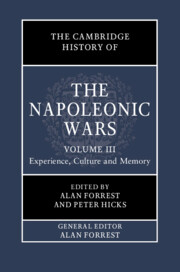Book contents
- The Cambridge History of the Napoleonic Wars
- The Cambridge History of the Napoleonic Wars
- The Cambridge History of the Napoleonic Wars
- Copyright page
- Contents
- Figures
- Maps
- Contributors to Volume III
- Introduction to Volume III
- Part I The Experience of War
- 1 The Soldiers’ Experience of War
- 2 Military Values: Heroism and Masculinity
- 3 Military Medicine
- 4 Women and the Home Front
- 5 Prisoners of War
- Part II The Experience of Imperial Rule
- Part III War, Culture and Memory
- Part IV The Aftermath and Legacy of the Wars
- Bibliographic Essays
- Index
5 - Prisoners of War
from Part I - The Experience of War
Published online by Cambridge University Press: 05 August 2022
- The Cambridge History of the Napoleonic Wars
- The Cambridge History of the Napoleonic Wars
- The Cambridge History of the Napoleonic Wars
- Copyright page
- Contents
- Figures
- Maps
- Contributors to Volume III
- Introduction to Volume III
- Part I The Experience of War
- 1 The Soldiers’ Experience of War
- 2 Military Values: Heroism and Masculinity
- 3 Military Medicine
- 4 Women and the Home Front
- 5 Prisoners of War
- Part II The Experience of Imperial Rule
- Part III War, Culture and Memory
- Part IV The Aftermath and Legacy of the Wars
- Bibliographic Essays
- Index
Summary
In 1807, Charles Williams, who, under the pseudonym Ansell, was one of the leading caricaturists of his age, responded to the Battle of Eylau with an unusual satire (Figure 5.1). The composition played on tropes of British caricature with, at its core, a belittled emperor trapped in the clutches of the Russian bear, desperate to save face through propagandist bulletins, yet hardly concealing his ambition to conquer the East. Unusually, his army’s ‘winter quarters’ featured a space rarely represented in caricatures of the period: a prison. This depiction is revealing and raises questions about the significance of captivity during the conflict. Here, the prisoners are not subject to derision. Only the façade of a jail is to be seen. Inscribed ‘Prisoners of War’ and surmounted by a Russian Eagle, the building confines a mass of indistinct faces pressed against heavily barred windows. These are presumably the ‘7,000 Prisoners’ from Napoleon’s legions mentioned in the darkening cloud of news that Talleyrand is muffling with a dispatch trumpeting the Emperor’s victory to Paris.
- Type
- Chapter
- Information
- The Cambridge History of the Napoleonic Wars , pp. 93 - 114Publisher: Cambridge University PressPrint publication year: 2022



